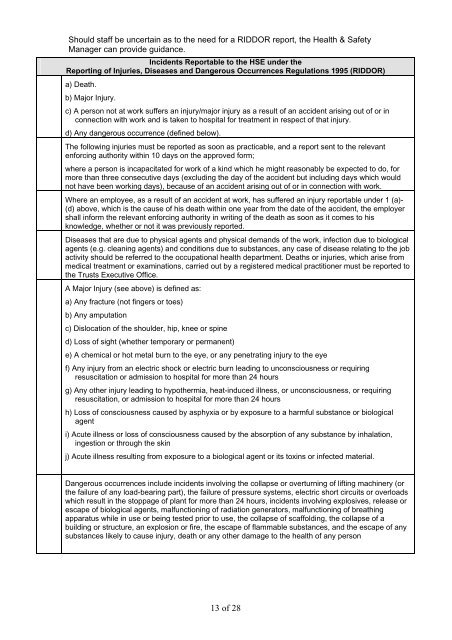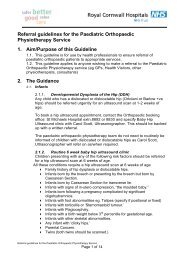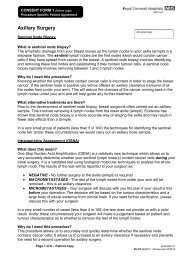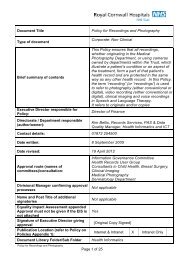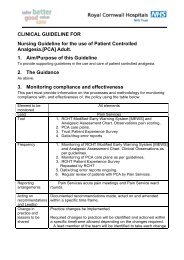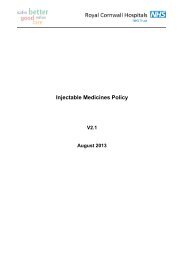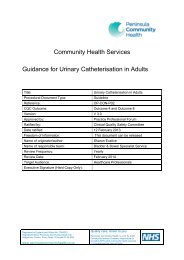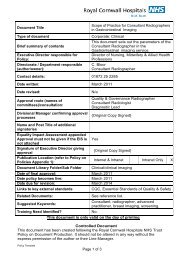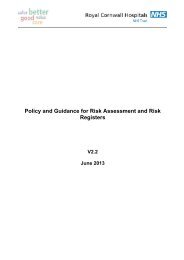Incident Management Policy Including Serious Incidents Requiring ...
Incident Management Policy Including Serious Incidents Requiring ...
Incident Management Policy Including Serious Incidents Requiring ...
Create successful ePaper yourself
Turn your PDF publications into a flip-book with our unique Google optimized e-Paper software.
Should staff be uncertain as to the need for a RIDDOR report, the Health & SafetyManager can provide guidance.<strong>Incident</strong>s Reportable to the HSE under theReporting of Injuries, Diseases and Dangerous Occurrences Regulations 1995 (RIDDOR)a) Death.b) Major Injury.c) A person not at work suffers an injury/major injury as a result of an accident arising out of or inconnection with work and is taken to hospital for treatment in respect of that injury.d) Any dangerous occurrence (defined below).The following injuries must be reported as soon as practicable, and a report sent to the relevantenforcing authority within 10 days on the approved form;where a person is incapacitated for work of a kind which he might reasonably be expected to do, formore than three consecutive days (excluding the day of the accident but including days which wouldnot have been working days), because of an accident arising out of or in connection with work.Where an employee, as a result of an accident at work, has suffered an injury reportable under 1 (a)-(d) above, which is the cause of his death within one year from the date of the accident, the employershall inform the relevant enforcing authority in writing of the death as soon as it comes to hisknowledge, whether or not it was previously reported.Diseases that are due to physical agents and physical demands of the work, infection due to biologicalagents (e.g. cleaning agents) and conditions due to substances, any case of disease relating to the jobactivity should be referred to the occupational health department. Deaths or injuries, which arise frommedical treatment or examinations, carried out by a registered medical practitioner must be reported tothe Trusts Executive Office.A Major Injury (see above) is defined as:a) Any fracture (not fingers or toes)b) Any amputationc) Dislocation of the shoulder, hip, knee or spined) Loss of sight (whether temporary or permanent)e) A chemical or hot metal burn to the eye, or any penetrating injury to the eyef) Any injury from an electric shock or electric burn leading to unconsciousness or requiringresuscitation or admission to hospital for more than 24 hoursg) Any other injury leading to hypothermia, heat-induced illness, or unconsciousness, or requiringresuscitation, or admission to hospital for more than 24 hoursh) Loss of consciousness caused by asphyxia or by exposure to a harmful substance or biologicalagenti) Acute illness or loss of consciousness caused by the absorption of any substance by inhalation,ingestion or through the skinj) Acute illness resulting from exposure to a biological agent or its toxins or infected material.Dangerous occurrences include incidents involving the collapse or overturning of lifting machinery (orthe failure of any load-bearing part), the failure of pressure systems, electric short circuits or overloadswhich result in the stoppage of plant for more than 24 hours, incidents involving explosives, release orescape of biological agents, malfunctioning of radiation generators, malfunctioning of breathingapparatus while in use or being tested prior to use, the collapse of scaffolding, the collapse of abuilding or structure, an explosion or fire, the escape of flammable substances, and the escape of anysubstances likely to cause injury, death or any other damage to the health of any person13 of 28


